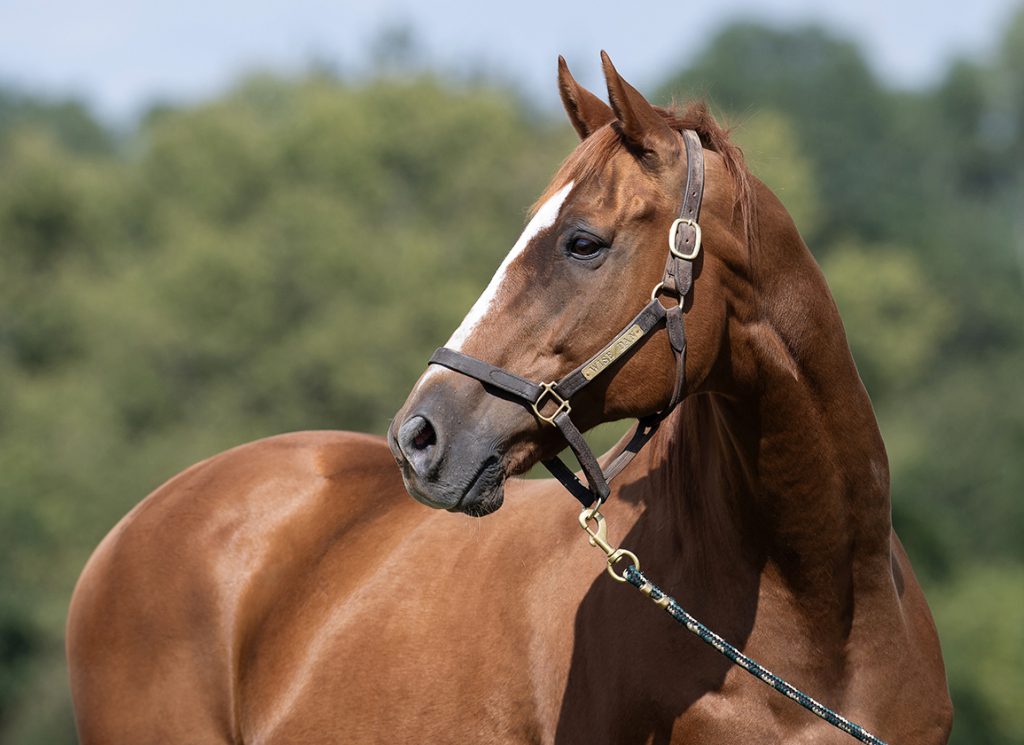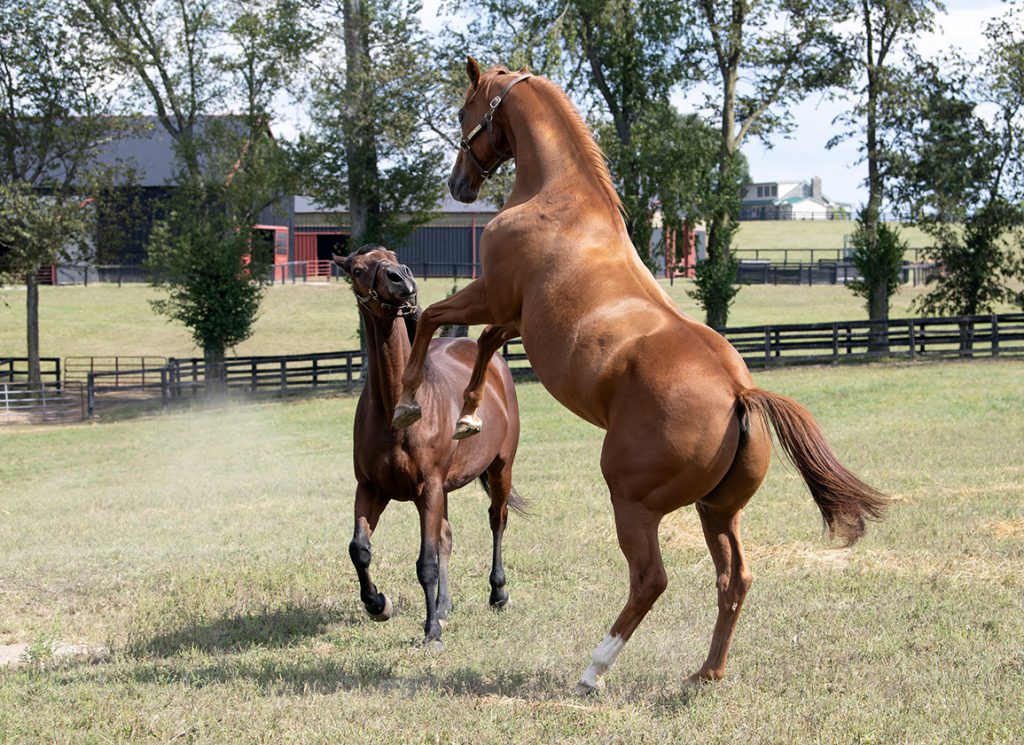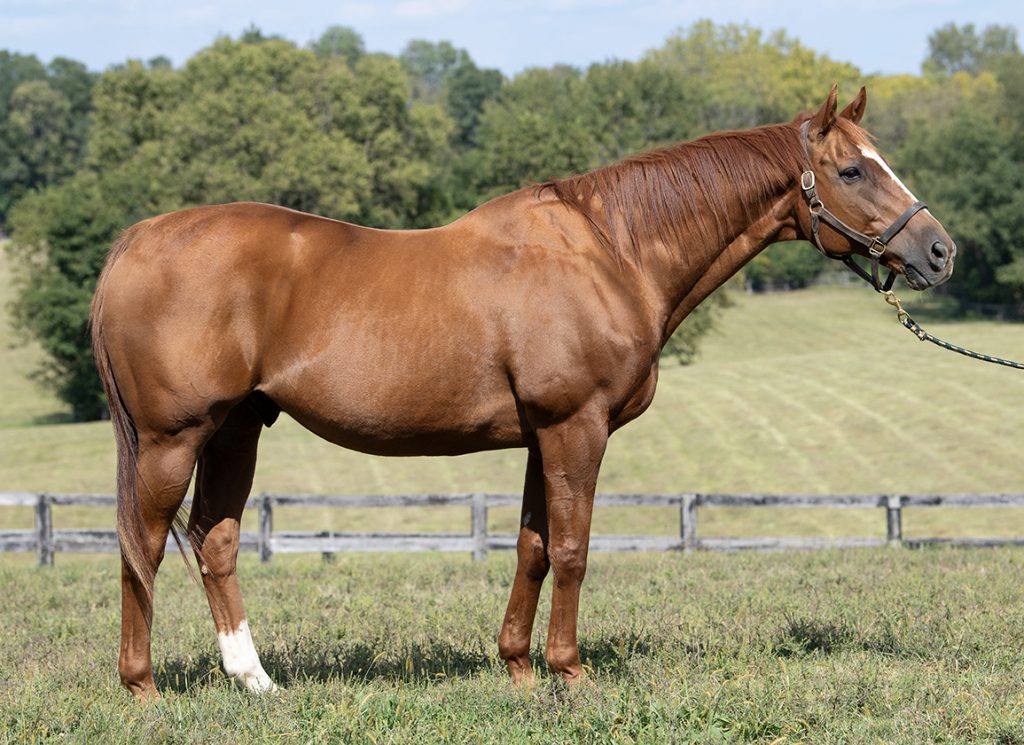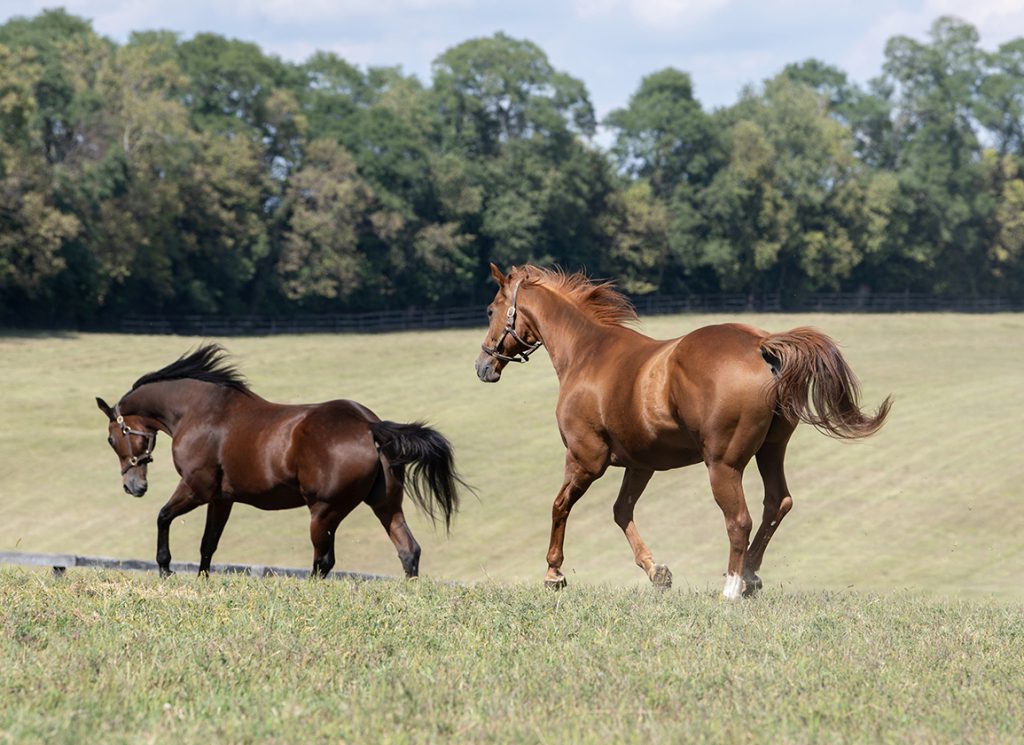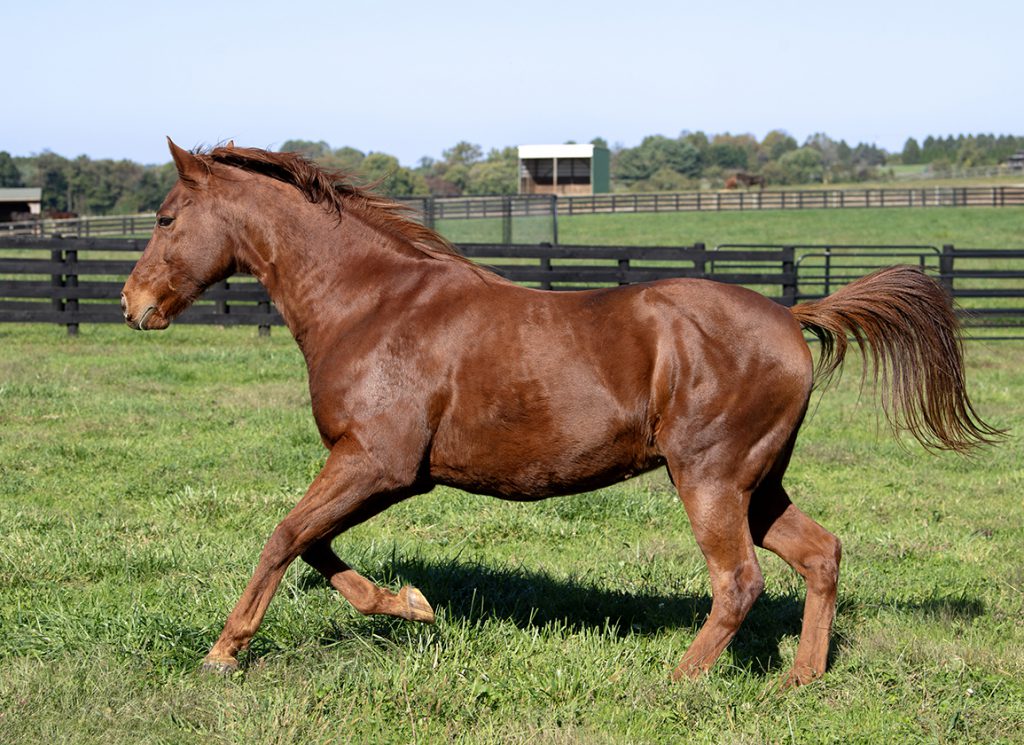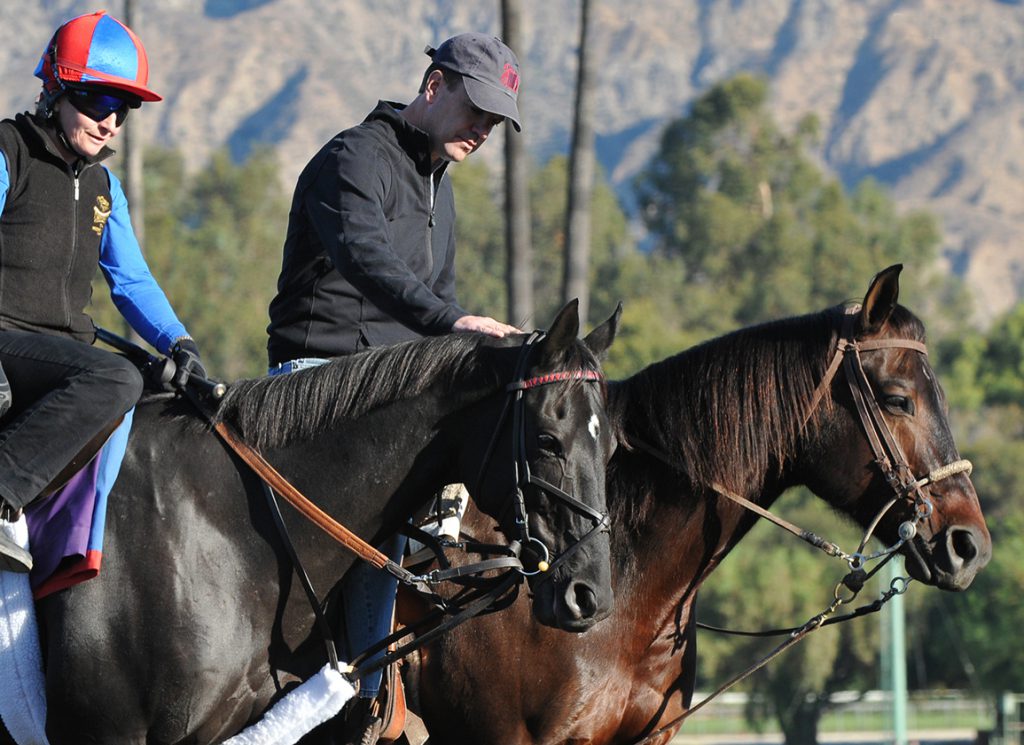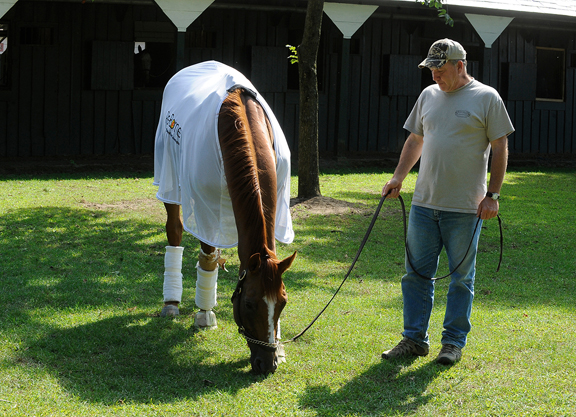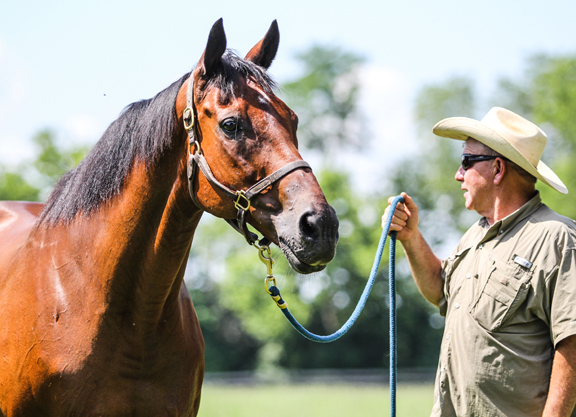Celebrating 40 Years of the Breeders' Cup
John Henry famously didn't make it to the Breeders' Cup. Da Hoss famously did, after a two-year layoff with a mere allowance prep. In this industry, where geldings at the elite levels are the exception and not the norm, those geldings tend to become beloved fan favorites. Perhaps it's because they often have longer race careers than their compatriots whose breeding careers must be considered.
Right up there in the lexicon of the special 31 geldings to have won a Breeders' Cup are two industry favorites living their best lives as retirees with the people who knew them best: Wise Dan and Main Sequence. These two glorious geldings may now be retired from the racetrack, but they both still live with their trainers, Charlie LoPresti and Graham Motion, respectively.
“He lives with us and that should show how special he is,” said Motion of Main Sequence.
Neither had a future in the stud barn, neither was transformed into a show horse, neither became a track pony, neither is even a riding horse. Instead, both Wise Dan and Main Sequence are beloved pasture pets, each turned out with a buddy, each living the life of Riley, each with the assurance of LoPresti and Motion meeting their every need.
Both champions–one as a homebred always destined to race as such and one as a homebred originally intended for the sales–these two horses gave so many thrills to their connections. No wonder their trainers couldn't imagine them living anywhere else and plan to cater to each one's every need for life.
The two chestnuts took very different routes to each trainer's barn. Wise Dan has spent nearly every moment of his life, since he was a short yearling, in LoPresti's care. Motion doesn't remember laying eyes on Main Sequence until he was a 5-year-old who had already won a Group race in England and finished second in the G1 Investec Epsom Derby for trainer David Lanigan.
“Wise Dan was foaled at Patchen Wilkes Farm in Lexington and Mr. [Morton] Fink always sent those babies to us when they were short yearlings,” remembered LoPresti. “I don't remember the exact month, but we pretty much raised him from a short yearling. We broke him, we trained him, we did everything with him.
“He was a big, strong horse,” continued LoPresti. “I wouldn't say he was difficult, but the only thing that stood out in my mind early was how different he was than other horses. Once I figured out that his stride was so much longer than most horses, he was easy to get along with. At first, we were always trying to bottle him up or slow him down, but once we figured out his natural rhythm was :13 or :14 [for an eighth], he was just a natural athlete. He is just an incredible horse, so smart. Just different than most horses.”
Everyone remembers Wise Dan as a two-time Breeders' Cup Mile winner, but what might not be remembered as well is he started his career on the dirt. He was a graded winner on the main track at three and even ran in the Breeders' Cup Sprint, finishing sixth. It was midway through his 4-year-old year that Wise Dan tried turf for the first time, winning the GII Firecracker H. at Churchill, but he didn't stay on the surface, adding the GI Clark H. and GII Fayette S. on dirt before the year was over. More graded success on the main track at five followed. It wasn't until August at Saratoga at age five in the GII Fourstardave H. that Wise Dan moved permanently to the grass and started one of the most remarkable streaks in recent memory. He would win his next nine in a row, including his first Breeders' Cup, and 14 of his final 15 races.
“I could tell you so many things about him,” said LoPresti, “but nothing really fazed him. He almost knew when he was going to run. He'd lay down or rest his head on the stall webbing. I would worry about post position, track condition, everything, but [rider] Johnny Velazquez would say, 'Don't' worry about it. He knows how to win, he knows how to get himself out of trouble.' And he did! He did it every time he won and pulled it off. Nineteen graded stakes he won.
“Part of the thing with him was how he took everything in stride,” continued LoPresti. “When he got to Santa Anita for his Breeders' Cup wins, the first thing he did was just stare at the San Gabriel Mountains like he knew what he was there for. He'd get in the stall–remember he'd never been there before–make two or three turns around and settle down to eat. Most horses take a little while to settle in. He wouldn't. He never got upset about anything. If there was a loose horse, he would just watch like he was saying, 'What's wrong with you?'
“That's the thing about him: he took everything in stride and he always knew how to win.”
He certainly did. During his five-year racing career, Wise Dan won 23 of his 31 starts. No fewer than 11 of his 19 graded wins were in Grade I races. He set track or course records at Santa Anita, Keeneland, and Woodbine. But not everything was smooth sailing. He came back from small injuries. And the sport held its collective breath when Wise Dan colicked and underwent surgery.
“When they turned him over on the table and opened him up,” remembered LoPresti, “the surgeon turned around and gave me a thumbs up. He'd untwisted when they turned him over, so they didn't have to mess with anything and they just sewed him back up. The only thing we were dealing with then was the healing of the incision. Yes, that's a lot, but he was just so tough. That son of a gun came back from the clinic bouncing off the van! All we had to do was heal his incision.”
LoPresti said he got some flack for bringing Wise Dan back after the surgery and expecting him to perform at the same level. What some people forget is that no one knew him better than LoPresti and no one had his best interests more in mind.
“I knew a lot of people thought I was crazy to bring him back. His first couple of works were not brilliant and I can remember reading stuff after those works–he's not the same horse, you know, all the naysayers–but all I was trying to do was keep him from being stressed and bring him along slow. Then we started to build. That's where I wanted him. We didn't pressure him; we wanted to go along easy and make sure he wasn't going to colic again. Then he came back and he won. And he won again. I always worried. When people start talking, you start to second guess yourself, but I started to see the light come back on and I knew he was back.”
Back indeed. Wise Dan would close out his career as a two-time Horse of the Year and a legend.
“I just want everybody to realize what kind of horse he really was, everything he came through, everything he did. He won $7.5 million and 19 graded stakes and he didn't run for mega-purses. He earned it. If you look at all his races, a lot of them were small stakes. He didn't go to Dubai; there was no Pegasus Cup. I was very fortunate that I had a farm and owners who trusted what I did. I always gave my horses the winter off, never took them to Florida or Louisiana. That was to my demise as a trainer for business, but the old racing families, the old, true sportsmen, got it. I was just fortunate that I had owners that let me do that. Nowadays, if you don't travel and dance every dance, you're going to lose horses. I have really fond memories looking back.”
LoPresti, who quietly retired from training at the end of 2020, said it wasn't just his family and the public who loved Wise Dan. The horse also gave his owner-breeder a reason to live.
“Mr. Fink went to dialysis two or three days a week. That horse kept him alive. The idea of having to go watch him run and watch his next race. That was why we didn't go overseas or to Dubai or anything. Mr. Fink wanted to watch him in person and he really couldn't travel that far. We weren't there for the money. Mr. Fink enjoyed the horse and being able to go see him. I totally understood. I believe he could have gone over to Dubai and won, but that's not what Mr. Fink wanted to do. I was fine with that.”
Wise Dan's last race–and win–was in 2014 in the GI Shadwell Turf Mile at Keeneland. No one knew at the time it would be his last race, but some small, niggling injuries kept him from returning. When he was officially retired 11 months later just before an attempt at a third GI Woodbine Mile, it was decided 'Dan' would live out his days at LoPresti's farm. LoPresti indicated the Kentucky Horse Park and Old Friends were both interested in having him, “But this is what we all decided. We know him. He was raised here. Why send him somewhere he doesn't know and take him away from his brother?”
That half-brother is the one-year older MGW & MGISP Successful Dan, also a Fink homebred campaigned by LoPresti. Successful Dan and Wise Dan are thick as thieves. They're turned out together, they play hard, and they keep themselves extremely fit, said LoPresti. They're also very attached to each other.
“Not too long ago, Successful Dan got a little hurt and needed some stitches. He needed to stay in the barn for a week. Wise Dan never went more than 30 yards away. He kept checking on him,” said LoPresti.
“Wise Dan is just different from other horses. He's so smart. All the great ones are just different. That's what makes them what they are. Of course, they have to have the athletic ability, too, and he did with that natural rhythm, that natural stride.
“He's very kind, but also very strong. When he decides he wants to go out to the paddock or when he went to gallop at the track, he's going to take you where he wants to go. It's impossible to slow him down.”
Wise Dan's Breeders' Cup wins were in 2012 and 2013; he was undefeated in four starts in 2014, but didn't make the Breeders' Cup that year. Main Sequence, another turfer, did. The two never faced each other on the track, as Wise Dan specialized at a mile and Main Sequence wanted longer. The latter won the 12-furlong Breeders' Cup Turf in 2014. He took a far different road getting there than Wise Dan did.
“Honestly, he wasn't the most straightforward horse to train,” said Motion of Main Sequence. “He could be a little bit tricky. He certainly has a lot of personality.”
Lanigan, a former UK-based trainer who is now with Four Star Sales in Kentucky, laid it out plainly.
“He was a pain in the ass!” said Lanigan, who first trained Main Sequence in England, with a laugh. Lanigan and Motion both trained for the Niarchos family's Flaxman Holdings.
“He was a difficult horse, a little bit quirky,” continued Lanigan. “He didn't like to lead the string, didn't show much on the gallops. But he was a big, mature, good-looking horse who coped with everything very good. We were surprised when he won his maiden first time at two. None of mine usually won first time out. They improved more from first to second run. There was a good horse of Godolphin's in there that cost a lot of money and he beat him quite well. Then we sent him to a novice at Newmarket. It was more of a fact-finding mission to see if he was as nice as we thought he was. There were useful sorts in there and he won that very well.
“Then I managed to convince [owner] Maria [Niarchos-Gouaze of Flaxman Holdings] and [Flaxman's racing manager] Alan [Cooper] to supplement him for the Derby… The boldness in me! I couldn't leave a Derby horse on the table. I had to spend the next six months trying to convince Alan to run him.”
Main Sequence ended up going to the Derby undefeated in four starts, including in the G3 Betfred Derby Trial. He suffered his first career defeat in the Derby to Aidan O'Brien's Camelot (GB) with Queen Elizabeth II in attendance. The performance may have been assurance that Main Sequence was as good of a horse as Lanigan thought, but that loss was also tough to swallow.
“It broke my heart,” said Lanigan. “Nobody ever remembers second. He was beaten by a very good horse and ran his race, but I was gutted for myself because I knew we had a very nice horse. And I was very disappointed for Maria. She was one of the first people to send me a horse when I started training. She was always a very good supporter and friend, so it wasn't just my own selfishness. I was very disappointed for her.”
Main Sequence and Lanigan were together for approximately another year and a half after the Derby, long before the Breeders' Cup was on the table. Lanigan had actually picked the chestnut out of the Keeneland September sale as a yearling. The horse had been entered, but Lanigan said Niarchos-Gouaze had asked him if there were any of hers in the crop he liked. When Lanigan picked Main Sequence, he never went through the ring and was shipped to the UK instead. Lanigan and the horse were together for nearly three years total and came to an understanding.
“Like a lot of good horses, you could set your watch by him. He went out first lot every day, would have his breakfast, then go to sleep. He'd be comatose from 9-12, head under the shavings. I took him out for a pick of grass every day myself. He was a bit of a handful. Out of nowhere, he'd stand straight up on his hind legs.
“He overcame a lot. He had a tiny bit of a kissing spine after he won his novice as a 2-year-old, but after that never missed another day. We gelded him at the end of his 3-year-old year because he didn't really have a stallion's pedigree. He was a little bit of a bridesmaid at four. He'd get himself very warm in paddocks that year, which he never did before, so it was sort of a frustrating year.
“I told Maria, 'There's a better chance for him over in America. You could win a Breeders' Cup with him in America, but we're going to struggle with him in Europe.'”
Prophetic words, it turns out. Lanigan said shipping him back and forth was considered, but it was ultimately decided it would be better for the horse to be based in the same area he'd run, rather than to ship. Lanigan was fully on board.
“I told Maria it was going to be a wasted opportunity for the horse and for her if she didn't do it. It all worked out very well. Maria and the horse were the most important two in the whole thing. She's an owner who deserves the very best. It was a pleasure to have had him and I feel very lucky to have had him.”
Motion was the lucky recipient in America. Although Motion had been to Lanigan's yard in Lambourn when he stabled his GI Kentucky Derby and G1 Dubai World Cup winner Animal Kingdom there prior to a run at Royal Ascot, he didn't have any particular memories of Main Sequence in the flesh before he came to America.
“Obviously he'd been in some nice races already, so you knew he was a good horse,” said Motion. “I was aware of him because we all trained for Flaxman and he'd certainly done well in some nice races–had that second in the Derby–but I didn't really know him before. I think the whole team felt that American racing might suit him. We kind of all made all those decisions together, with David Lanigan and Alan Cooper.
“Main Sequence actually got quite sick when he first came to me. Shipping over the winter is tough, having to travel and quarantine on both sides. It took him a while to get over it. We gave him a lot of time.”
The repatriated Main Sequence would not make his American debut under Motion's care until July of 2014. He would win that day–the GI United Nations S.–and wouldn't lose that year, adding the Sword Dancer, Joe Hirsch Turf Classic, and Breeders' Cup Turf, all Grade Is. The campaign culminated in a championship.
“We did things with him that I hadn't really done with a horse,” said Motion, “in all the extra schooling. He required a lot of time in working with those things. He was always a little slow to come away from the gates, so we worked on that quite a lot. The first time he ran for us, in the UN, he walked out of the gate. He gave us fits with that.
“His first three races were by a neck, a head, and a neck. It was a testament to Rajiv [Maragh], who rode him so well.”
Maragh was not able to be aboard for the Breeders' Cup. Velazquez, who had piloted Wise Dan to his first Breeders' Cup win, but had gotten injured earlier on the card of Wise Dan's second Breeders' Cup victory and was hospitalized as the race ran, had to substitute for Maragh in this Breeders' Cup.
“It was tough,” said Motion, “because Rajiv had won on him in the Turf Classic and while we were up in the reception room after the race [just over 30 minutes later], Rajiv had his terrible accident and broke his arm. We were good friends with him and Angie, his wife, so there were a lot of emotions when he got hurt. I get emotional now just thinking about it. So Johnny rode him in the Breeders' Cup. That was the year he was coming off that bad accident of the year before in the Breeders' Cup.”
Maragh needed two plates and 13 screws to repair his arm and would win on Main Sequence again in 2015. Velazquez had emergency surgery after a spill in the Juvenile Fillies in 2014 that resulted in pancreas repair and spleen removal. Motion is close friends with both riders.
“On Breeders' Cup Day was the only time Main Sequence ever broke properly. He won handily,” said Motion. After winning the GII Mac Diarmida S. the next year, Main Sequence tried Dubai and for a repeat in the United Nations, but didn't perform as hoped in the latter and it was discovered he had suffered a tendon tear. He was retired.
“Alan and Maria were nice enough to let him stay here after his career,” said Motion. “These horses were so influential in my career.”
Motion mentioned Better Talk Now, his very first Breeders' Cup winner. Better Talk Now, who also won the Turf a decade before Main Sequence, also retired to Motion's Fair Hill home base. He passed away in 2017 following complications from colic surgery.
“Main Sequence is a bit like Better Talk Now,” said Motion. “Neither one of them were particularly nice horses to ride. They both had the same kind of personality: pretty cantankerous, pretty tough, which is probably an indicator of how good they were.”
Main Sequence now lives in a paddock with Bye Bye Melvin, another former Motion runner who ran in the 2022 Breeders' Cup Turf.
“I have to be very careful who we put out in the paddock with him, because he's pretty tough on other horses, but he and Bye Bye Melvin get along great.”
Main Sequence served as an ambassador at the Maryland 5* event earlier this month.
“That was quite a shock to him to come out of his field for the first time in years,” said Motion with a laugh. “He was a little wound up, but it was very cool. A lot of people came by to see him. I heard he only bit one person, but we made it through. It was just a mile up the road, so we decided to do it.”
Like LoPresti with Wise Dan, Motion has incredibly fond memories of his Breeders' Cup win with Main Sequence.
“It was very rewarding,” said Motion. “It was really a team effort to win a Breeders' Cup race for the Niarchos family. I grew up watching them, so it was like a dream to win for them. It was sort of coming full circle. We love the Breeders' Cup.”
The post Wise Dan and Main Sequence, Two Glorious Geldings and the Breeders’ Cup appeared first on TDN | Thoroughbred Daily News | Horse Racing News, Results and Video | Thoroughbred Breeding and Auctions.
